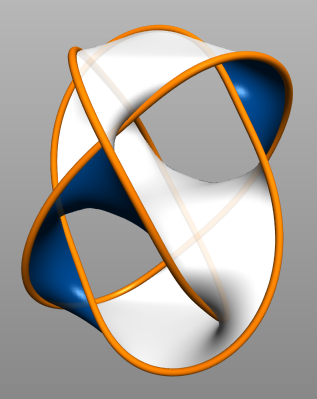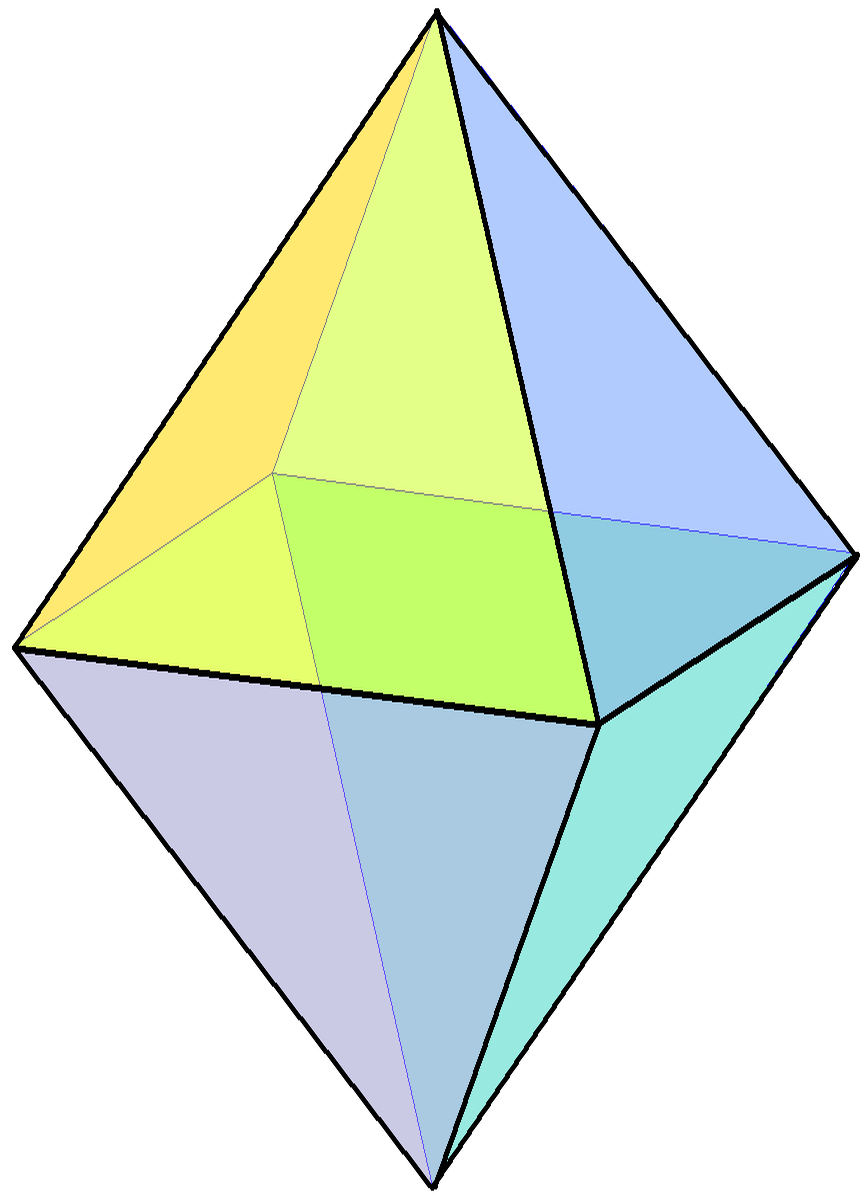|
Barycentric Subdivision
In mathematics, the barycentric subdivision is a standard way to subdivide a given simplex into smaller ones. Its extension to simplicial complexes is a canonical method to refining them. Therefore, the barycentric subdivision is an important tool in algebraic topology. Motivation The barycentric subdivision is an operation on simplicial complexes. In algebraic topology it is sometimes useful to replace the original spaces with simplicial complexes via triangulations: This substitution allows one to assign combinatorial invariants such as the Euler characteristic to the spaces. One can ask whether there is an analogous way to replace the continuous functions defined on the topological spaces with functions that are linear on the simplices and homotopic to the original maps (see also simplicial approximation). In general, such an assignment requires a refinement of the given complex, meaning that one replaces larger simplices with a union of smaller simplices. A standard way to c ... [...More Info...] [...Related Items...] OR: [Wikipedia] [Google] [Baidu] [Amazon] |
Omnitruncation
In geometry, an omnitruncation of a convex polytope is a simple polytope of the same dimension, having a vertex for each flag of the original polytope and a facet for each face of any dimension of the original polytope. Omnitruncation is the dual operation to barycentric subdivision. Because the barycentric subdivision of any polytope can be realized as another polytope, the same is true for the omnitruncation of any polytope. When omnitruncation is applied to a regular polytope (or honeycomb) it can be described geometrically as a Wythoff construction that creates a maximum number of facets. It is represented in a Coxeter–Dynkin diagram with all nodes ringed. It is a ''shortcut'' term which has a different meaning in progressively-higher-dimensional polytopes: * Uniform polytope truncation operators ** For regular polygons: An ordinary truncation, t_\ = t\ = \. *** Coxeter-Dynkin diagram ** For uniform polyhedra (3-polytopes): A cantitruncation, t_\ = tr\. (Application ... [...More Info...] [...Related Items...] OR: [Wikipedia] [Google] [Baidu] [Amazon] |
Geometric Topology
In mathematics, geometric topology is the study of manifolds and Map (mathematics)#Maps as functions, maps between them, particularly embeddings of one manifold into another. History Geometric topology as an area distinct from algebraic topology may be said to have originated in the 1935 classification of lens spaces by Reidemeister torsion, which required distinguishing spaces that are homotopy equivalent but not homeomorphic. This was the origin of simple homotopy, ''simple'' homotopy theory. The use of the term geometric topology to describe these seems to have originated rather recently. Differences between low-dimensional and high-dimensional topology Manifolds differ radically in behavior in high and low dimension. High-dimensional topology refers to manifolds of dimension 5 and above, or in relative terms, embeddings in codimension 3 and above. Low-dimensional topology is concerned with questions in dimensions up to 4, or embeddings in codimension up to 2. Dimensio ... [...More Info...] [...Related Items...] OR: [Wikipedia] [Google] [Baidu] [Amazon] |
Algebraic Topology
Algebraic topology is a branch of mathematics that uses tools from abstract algebra to study topological spaces. The basic goal is to find algebraic invariant (mathematics), invariants that classification theorem, classify topological spaces up to homeomorphism, though usually most classify up to Homotopy#Homotopy equivalence and null-homotopy, homotopy equivalence. Although algebraic topology primarily uses algebra to study topological problems, using topology to solve algebraic problems is sometimes also possible. Algebraic topology, for example, allows for a convenient proof that any subgroup of a free group is again a free group. Main branches Below are some of the main areas studied in algebraic topology: Homotopy groups In mathematics, homotopy groups are used in algebraic topology to classify topological spaces. The first and simplest homotopy group is the fundamental group, which records information about loops in a space. Intuitively, homotopy groups record information ... [...More Info...] [...Related Items...] OR: [Wikipedia] [Google] [Baidu] [Amazon] |
Exact Sequence
In mathematics, an exact sequence is a sequence of morphisms between objects (for example, groups, rings, modules, and, more generally, objects of an abelian category) such that the image of one morphism equals the kernel of the next. Definition In the context of group theory, a sequence :G_0\;\xrightarrow\; G_1 \;\xrightarrow\; G_2 \;\xrightarrow\; \cdots \;\xrightarrow\; G_n of groups and group homomorphisms is said to be exact at G_i if \operatorname(f_i)=\ker(f_). The sequence is called exact if it is exact at each G_i for all 1\leq i |
Singular Homology
In algebraic topology, singular homology refers to the study of a certain set of algebraic invariants of a topological space X, the so-called homology groups H_n(X). Intuitively, singular homology counts, for each dimension n, the n-dimensional holes of a space. Singular homology is a particular example of a homology theory, which has now grown to be a rather broad collection of theories. Of the various theories, it is perhaps one of the simpler ones to understand, being built on fairly concrete constructions (see also the related theory simplicial homology). In brief, singular homology is constructed by taking maps of the simplex, standard -simplex to a topological space, and composing them into Free abelian group#Integer functions and formal sums, formal sums, called singular chains. The boundary operation – mapping each n-dimensional simplex to its (n-1)-dimensional boundary operator, boundary – induces the singular chain complex. The singular homology is then ... [...More Info...] [...Related Items...] OR: [Wikipedia] [Google] [Baidu] [Amazon] |
Simplicial Homology
In algebraic topology, simplicial homology is the sequence of homology groups of a simplicial complex. It formalizes the idea of the number of holes of a given dimension in the complex. This generalizes the number of connected component (topology), connected components (the case of dimension 0). Simplicial homology arose as a way to study topological spaces whose building blocks are ''n''-simplices, the ''n''-dimensional analogs of triangles. This includes a point (0-simplex), a line segment (1-simplex), a triangle (2-simplex) and a tetrahedron (3-simplex). By definition, such a space is homeomorphic to a simplicial complex (more precisely, the abstract simplicial complex, geometric realization of an abstract simplicial complex). Such a homeomorphism is referred to as a ''Triangulation (topology), triangulation'' of the given space. Many topological spaces of interest can be triangulated, including every smooth manifold (Cairns and J.H.C. Whitehead, Whitehead). Simplicial homology ... [...More Info...] [...Related Items...] OR: [Wikipedia] [Google] [Baidu] [Amazon] |
Disdyakis Dodecahedron
In geometry, a disdyakis dodecahedron, (also hexoctahedron, hexakis octahedron, octakis cube, octakis hexahedron, kisrhombic dodecahedron) or d48, is a Catalan solid with 48 faces and the dual to the Archimedean truncated cuboctahedron. As such it is face-transitive but with irregular face polygons. It resembles an augmented rhombic dodecahedron. Replacing each face of the rhombic dodecahedron with a flat pyramid results in the Kleetope of the rhombic dodecahedron, which looks almost like the disdyakis dodecahedron, and is topologically equivalent to it. The net of the rhombic dodecahedral pyramid also shares the same topology. Symmetry It has Oh octahedral symmetry. Its collective edges represent the reflection planes of the symmetry. It can also be seen in the corner and mid-edge triangulation of the regular cube and octahedron, and rhombic dodecahedron. The edges of a spherical disdyakis dodecahedron belong to 9 great circles. Three of them form a spherical octahedron ... [...More Info...] [...Related Items...] OR: [Wikipedia] [Google] [Baidu] [Amazon] |
Regular Octahedron
In geometry, a regular octahedron is a Platonic solid composed of eight equilateral triangles, four of which meet at each vertex. Regular octahedra occur in nature as crystal structures. An octahedron, more generally, can be any eight-sided polyhedron; many types of irregular octahedra also exist. A regular octahedron is convex, meaning that for any two points within it, the line segment connecting them lies entirely within it. It is one of the eight convex deltahedra because all of the faces are equilateral triangles. It is a composite polyhedron made by attaching two equilateral square pyramids. Its dual polyhedron is the cube, and they have the same three-dimensional symmetry groups, the octahedral symmetry \mathrm_\mathrm . A regular octahedron is a special case of an octahedron, any eight-sided polyhedron. It is the three-dimensional case of the more general concept of a cross-polytope. As a Platonic solid The regular octahedron is one of the Platonic solids, a s ... [...More Info...] [...Related Items...] OR: [Wikipedia] [Google] [Baidu] [Amazon] |
Cube
A cube or regular hexahedron is a three-dimensional space, three-dimensional solid object in geometry, which is bounded by six congruent square (geometry), square faces, a type of polyhedron. It has twelve congruent edges and eight vertices. It is a type of parallelepiped, with pairs of parallel opposite faces, and more specifically a rhombohedron, with congruent edges, and a rectangular cuboid, with right angles between pairs of intersecting faces and pairs of intersecting edges. It is an example of many classes of polyhedra: Platonic solid, regular polyhedron, parallelohedron, zonohedron, and plesiohedron. The dual polyhedron of a cube is the regular octahedron. The cube can be represented in many ways, one of which is the graph known as the cubical graph. It can be constructed by using the Cartesian product of graphs. The cube is the three-dimensional hypercube, a family of polytopes also including the two-dimensional square and four-dimensional tesseract. A cube with 1, unit s ... [...More Info...] [...Related Items...] OR: [Wikipedia] [Google] [Baidu] [Amazon] |
Flag (geometry)
In (polyhedral) geometry, a flag is a sequence of Face (geometry), faces of a Abstract polytope, polytope, each contained in the next, with exactly one face from each dimension. More formally, a flag of an -polytope is a set such that and there is precisely one in for each , Since, however, the minimal face and the maximal face must be in every flag, they are often omitted from the list of faces, as a shorthand. These latter two are called improper faces. For example, a flag of a polyhedron comprises one Vertex (geometry), vertex, one Edge (geometry), edge incident to that vertex, and one polygonal face incident to both, plus the two improper faces. A polytope is regular polytope, regular if, and only if, its symmetry group is transitive group action, transitive on its flags. This definition excludes chiral polytopes. Two flags are -adjacent if they only differ by a face of rank . They are adjacent if they are -adjacent for some value of . Each flag is -adjacent to ... [...More Info...] [...Related Items...] OR: [Wikipedia] [Google] [Baidu] [Amazon] |
Facet (geometry)
In geometry, a facet is a feature of a polyhedron, polytope, or related geometric structure, generally of dimension one less than the structure itself. More specifically: * In three-dimensional geometry, some authors call a facet of a polyhedron any polygon whose corners are vertices of the polyhedron, including polygons that are not ''Face (geometry), faces''. To ''facetting, facet'' a polyhedron is to find and join such facets to form the faces of a new polyhedron; this is the reciprocal process to ''stellation'' and may also be applied to higher-dimensional polytopes. * In polyhedral combinatorics and in the general theory of polytopes, a Face (geometry), face that has dimension ''n'' − 1 (an (''n'' − 1)-face or hyperface) is called a Face (geometry)#Facet, facet. In this terminology, every facet is a face. * A facet of a simplicial complex is a maximal simplex, that is a simplex that is not a face of another simplex of the complex.. For (boundary complex ... [...More Info...] [...Related Items...] OR: [Wikipedia] [Google] [Baidu] [Amazon] |



